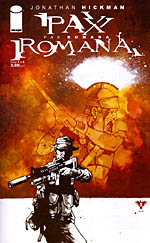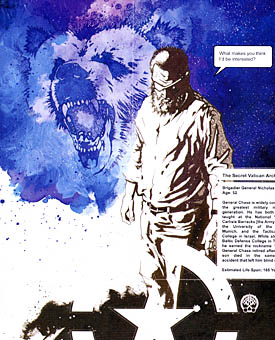 By Jonathan Hickman
By Jonathan Hickman
28 pages, color
Published by Image Comics
What is it with time-travel and alternate-timeline stories that involve the Roman Empire? Every time one turns around, a new one seems to crop up, ready for action. (The phenomenon is so commonplace that Lance Parkin’s novel Warlords of Utopia is about a war between every parallel universe where the Roman Empire, and every parallel universe where Nazi Germany was victorious.) The latest arrival in this genre is Jonathan Hickman’s Pax Romana. Can it transcend the tired genre that it’s placed itself squarely inside?
In a world where the Catholic church is failing in the near future, all seems lost until an unlikely invention is suddenly perfected—time travel. Now Pope Pius XIII realizes that he’s been handed a chance to restore the church to its former glory, before that power had even initially faded. But what can one warehouse full of mercenaries and technology really accomplish?
 Where Hickman succeeds the most in the first issue of Pax Romana, easily, is in his world-building. We’re given so many tantalizing glimpses into both the original and then the altered timeline that I’d be quite happy just reading a series of timelines breaking down how everything came to be. Tri-borders of territorial Muslim, Christian, and Black Axe Confraternity regions? Killing Fields of Pan-Africa? Megacity Constantinople? Series of genetically engineered Popes? This is great stuff, and Hickman doles out tantalizing hints left and right about the world to come as well as the world that never was. One gets a real strong sense about the care and thought that’s put into the comic, and that could bode quite well for me. I like the idea of Pax Romana being more about the big changes over time that happen because of the time travel, the larger picture around the world. On the other hand, what didn’t grab me were the actual characters, the “little picture” of Pax Romana. I never really got a handle on the time travel leader’s main character, or the two mercenaries we see him recruit. All three of them felt extremely clichéd to me, with no real hook to make me care about them. If the rest of the series is going to focus on them, I hope this is a problem that’s swiftly rectified in the second issue.
Where Hickman succeeds the most in the first issue of Pax Romana, easily, is in his world-building. We’re given so many tantalizing glimpses into both the original and then the altered timeline that I’d be quite happy just reading a series of timelines breaking down how everything came to be. Tri-borders of territorial Muslim, Christian, and Black Axe Confraternity regions? Killing Fields of Pan-Africa? Megacity Constantinople? Series of genetically engineered Popes? This is great stuff, and Hickman doles out tantalizing hints left and right about the world to come as well as the world that never was. One gets a real strong sense about the care and thought that’s put into the comic, and that could bode quite well for me. I like the idea of Pax Romana being more about the big changes over time that happen because of the time travel, the larger picture around the world. On the other hand, what didn’t grab me were the actual characters, the “little picture” of Pax Romana. I never really got a handle on the time travel leader’s main character, or the two mercenaries we see him recruit. All three of them felt extremely clichéd to me, with no real hook to make me care about them. If the rest of the series is going to focus on them, I hope this is a problem that’s swiftly rectified in the second issue.
 The art in Pax Romana is quite striking, a combination of drawings and splashes of painted color for background. It’s certainly an attractive look, thanks in no small part to Hickman’s strong eye for color combinations. The red-and-orange used in so much of this book is gorgeous, almost blistering off the page at the reader. The same is true with the deep blues used elsewhere, a deep hue that gives a great depth to the page that introduces Brigadier General Chase. Other background elements also really enhance the pages; papal seals, maps, satellite systems. That’s not to say that the foregrounds with people aren’t good, of course. I do like the way he draws people, especially their faces, which remind me a lot of portraits of the different characters. Hickman’s style seems more akin to snapshots than actual action, so you never really get a sense of motion or movement here, but strangely enough (perhaps because of the nature of the story for the first issue) I didn’t find myself missing it. I do have to say, though, that Hickman’s computer lettering is strangely distracting to me; it seems so cold and inorganic that it clashes with the rest of the art of the book. (While some or all of the art may have been also generated on the computer, there isn’t such a problem with that.)
The art in Pax Romana is quite striking, a combination of drawings and splashes of painted color for background. It’s certainly an attractive look, thanks in no small part to Hickman’s strong eye for color combinations. The red-and-orange used in so much of this book is gorgeous, almost blistering off the page at the reader. The same is true with the deep blues used elsewhere, a deep hue that gives a great depth to the page that introduces Brigadier General Chase. Other background elements also really enhance the pages; papal seals, maps, satellite systems. That’s not to say that the foregrounds with people aren’t good, of course. I do like the way he draws people, especially their faces, which remind me a lot of portraits of the different characters. Hickman’s style seems more akin to snapshots than actual action, so you never really get a sense of motion or movement here, but strangely enough (perhaps because of the nature of the story for the first issue) I didn’t find myself missing it. I do have to say, though, that Hickman’s computer lettering is strangely distracting to me; it seems so cold and inorganic that it clashes with the rest of the art of the book. (While some or all of the art may have been also generated on the computer, there isn’t such a problem with that.)
Pax Romana #1 is an interesting start to this four-issue mini-series, but I’m both curious and hesitant about where it will go from here. Hopefully we’ll continue to see the larger picture on display, but if the series does focus more on the individual characters then hopefully we’ll start to get a better feel for them. Despite being another entry in an overused genre, there’s enough innovation on display here that one doesn’t mind. I’m certainly interested in seeing more, and for that alone I’m impressed.
